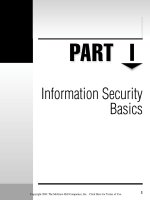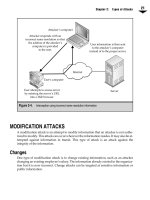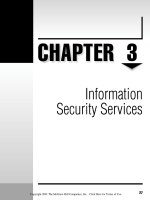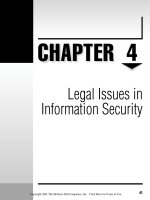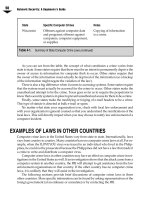Bảo mật hệ thống mạng part 20 pptx
Bạn đang xem bản rút gọn của tài liệu. Xem và tải ngay bản đầy đủ của tài liệu tại đây (141.25 KB, 10 trang )
CHAPTER
115
8
Information Security
Best Practices
Copyright 2001 The McGraw-Hill Companies, Inc. Click Here for Terms of Use.
116
Network Security: A Beginner’s Guide
T
he concept of “best practices” refers to a set of recommendations that generally pro
-
vides an appropriate level of security. Best practices are a combination of those
practices proved to be most effective at various organizations. Not all of these prac
-
tices will work for every organization. Some organizations will require additional poli
-
cies, procedures, training, or technical security controls to achieve appropriate risk
management.
The practices described in this chapter are intended to be a starting point for your or
-
ganization. These practices should be used in combination with a risk assessment to iden
-
tify measures that should be in place but are not or measures that are in place but are
ineffective.
ADMINISTRATIVE SECURITY
Administrative security practices are those that fall under the areas of policies and proce
-
dures, resources, responsibility, education, and contingency plans. These measures are in
-
tended to define the importance of information and information systems to the company
and to explain that importance to employees. Administrative security practices also define
the resources required to accomplish appropriate risk management and specify who has the
responsibility for managing the information security risk for the organization.
Policies and Procedures
The organization’s security policies define the way security is supposed to be within the
organization. Once policy is defined, it is expected that most employees will follow it.
With that said, you should also understand that full and complete compliance with pol-
icy will not occur. Sometimes policy will not be followed due to business requirements. In
other cases, policy will be ignored because of the perceived difficulty in following it.
Even given the fact that policy will not be followed all of the time, policy forms a key
component of a strong security program and thus must be included in a set of recom
-
mended practices. Without policy, employees will not know how the organization
expects them to protect the organization’s information and systems.
At a minimum, the following policies are recommended as best practices:
▼
Information Policy Defines the sensitivity of information within an
organization and the proper storage, transmission, marking, and disposal
requirements for that information.
■
Security Policy Defines the technical controls and security configurations that
users and administrators are required to implement on all computer systems.
■
Use Policy Identifies the approved uses of organization computer systems
and the penalties for misusing such systems. It will also identify the approved
method for installing software on company computers. This policy is also
known as the acceptable use policy.
▲
Backup Policy Defines the frequency of information backups and the
requirements for moving the backups to offsite storage. Backup policies may
also identify the length of time backups should be stored prior to reuse.
Policies alone do not provide sufficient guidance for an organization’s security pro
-
gram. Procedures must also be defined to guide employees when performing certain du
-
ties and identify the expected steps for different security-relevant situations. Procedures
that should be defined for an organization include
▼
Procedure for User Management This procedure would include information
as to who may authorize access to which of the organization’s computer systems
and what information is required to be kept by the system administrators to
identify users calling for assistance. User management procedures must also
define who has the responsibility for informing system administrators when an
employee no longer needs an account. Account revocation is critical to making
sure that only individuals with a valid business requirement have access to the
organization’s systems and networks.
▲ Configuration Management Procedures These procedures define the steps
for making changes to production systems. Changes may include upgrading
software and hardware, bringing new systems online, and removing systems
that are no longer needed.
Hand in hand with configuration management procedures are defined methodolo-
gies for new system design and turnover. Proper design methodologies are critical for
managing the risk of new systems and for protecting production systems from unautho-
rized changes.
Resources
Resources must be assigned to implement proper security practices. Unfortunately, there
is no formula that can be used to define how many resources (in terms of money or staff)
should be put against a security program based simply on the size of an organization.
There are just too many variables. The resources required depend on the size of the orga
-
nization, the organization’s business, and the risk to the organization.
It is possible to generalize the statement and say that the amount of resources should be
based on a proper and full risk assessment of the organization and the plan to manage the
risk. To properly define the required resources, you should apply a project management
approach. Figure 8-1 shows the relationship of resources, time, and scope for a project. If
the security program is treated as a project, the organization must supply sufficient
resources to balance the triangle or else extend the time or reduce the scope.
Chapter 8: Information Security Best Practices
117
118
Network Security: A Beginner’s Guide
Staff
No matter how large or small an organization is, some employee must be given the tasks
associated with managing the information security risk. For small organizations, this
may be part of the job assigned to a member of the information technology staff. Larger
organizations may have large departments devoted to security. Best practices do not rec-
ommend the size of the staff but they do strongly recommend that at least one employee
have security as part of his or her job description.
Security department staffs should have the following skills:
▼
Security Administration An understanding of the day-to-day administration
of security devices.
■
Policy Development Experience in the development and maintenance of
security policies, procedures, and plans.
■
Architecture An understanding of network and system architectures and the
implementation of new systems.
■
Research The examination of new security technologies to see how they may
affect the risk to the organization.
■
Assessment Experience conducting risk assessments of organizations or
departments. The assessment skill may include penetration and security testing.
▲
Audit Experience in conducting audits of systems or procedures.
While all of these skills are useful for an organization, small organizations may not be
able to afford staff with all of them. In this case, it is most cost-effective to keep a security
administrator or policy developer on staff and seek assistance from outside firms for the
other skills.
Figure 8-1.
The project management triangle
Chapter 8: Information Security Best Practices
119
Budget
The size of the security budget of an organization is dependent on the scope and
timeframe of the security project rather than on the size of the organization. Organiza
-
tions with strong security programs may have lower budgets than smaller organizations
that are just beginning to build a security program.
Nowhere is balance more important than with regard to the security budget. The se
-
curity budget should be divided between capital expenditures, current operations, and
training. Many organizations make the mistake of purchasing security tools without
budgeting sufficient monies for training on these tools. In other cases, organizations pur
-
chase tools with the expectation that staffing can be reduced or at the very least
maintained at current levels. In most cases, new security tools will not allow staffing
to be reduced.
Budgeting according to best practices should be based on security project plans
(which in turn should be based on the risk to the organization). Sufficient monies should
be budgeted to allow for the successful completion of security project plans.
Responsibility
Some position within an organization must have the responsibility for managing infor-
mation security risk. Recently, it has become common for larger organizations to assign
this responsibility to a specific executive-level position called the Chief Information Secu-
rity Officer (CISO). No matter how large an organization is, an executive-level position
should have this responsibility. Some organizations use the Chief Financial Officer as the
reporting point for the security function; others use the Chief Information Officer or the
Chief Technology Officer.
No matter which executive-level position is used as the reporting point, the executive
must understand that security is an important part of his or her job. The executive posi-
tion should have the authority to define the organization’s policy and sign off on all secu
-
rity-related policies. The position should also have the authority to enforce policy on
system administrators and those in charge of the physical security of the organization.
It is not expected that the executive will perform day-to-day security administrations
and functions. These functions can and should be delegated to the security staff.
The organization’s security officer should develop metrics so that progress toward
security goals can be measured. These metrics may include the number of vulnerabilities
on systems, progress against a security project plan, or progress toward best practices.
Education
The education of employees is one of the most important parts of managing information
security risk. Without employee knowledge and commitment, any attempts at managing
risk will fail. Best practices recommend that education take three forms:
▼
Preventative measures
■
Enforcement measures
▲
Incentive measures
Preventative Measures
Preventative measures provide employees with details about protecting an organiza
-
tion’s information resources. Employees should be told why the organization needs to
protect its information resources; understanding the reasons for taking preventative
measures will make them much more likely to comply with policies and procedures. It is
when employees are not told the reasons for security that they sometimes seek to circum
-
vent the established policies and procedures.
In addition to telling employees why security is important, you need to provide de
-
tails and techniques on how they can comply with the organization’s policy. Myths such
as “strong passwords are hard to remember and therefore have to be written down” must
be examined and corrected.
Strong preventative measures take many forms. Awareness programs should in
-
clude both publicity campaigns and employee training. Publicity campaigns should
include newsletter articles and posters. Electronic mail messages and pop-up windows
can be used to remind employees of their responsibilities. Key topics of publicity cam
-
paigns should be
▼ Common employee mistakes such as writing down or sharing passwords
■ Common security lapses such as giving too much information to a caller
■ Important security information such as who to contact if a security breach
is suspected
■ Current security topics such as anti-virus and remote access security
▲ Topics that can be of assistance to employees such as how to protect portable
computers while traveling
Employee security-awareness training classes should be targeted at various audi
-
ences within the organization. All new employees should be given a short class (approxi
-
mately one hour or less) during their orientation program. Other employees should be
given the same class approximately once every two years. These classes should cover the
following information:
▼
Why security is important to the organization
■
What the employee’s responsibilities with regard to security are
■
Detailed information regarding the organization’s policies on
information protection
■
Detailed information regarding the organization’s use policies
■
Suggested methods for choosing strong passwords
▲
Suggested methods for avoiding social engineering attacks including
the types of questions help desk employees will and will not ask
120
Network Security: A Beginner’s Guide
TEAMFLY
Team-Fly
®
Administrators should receive the basic employee security-awareness training and
additional training about their specific security responsibilities. These additional training
sessions should be shorter (approximately one-half hour) and cover the following topics:
▼
Latest hacker techniques
■
Current security threats
▲
Current security vulnerabilities and patches
Developers should receive the basic employee security-awareness training. Classes
for developers should also include additional topics regarding their responsibilities to in
-
clude security in the development process. These classes should focus on the develop
-
ment methodology and configuration management procedures.
Periodic status presentations should be made to the organization’s management
team, providing detailed risk assessments and plans for reducing risk. The presentations
should include discussions of metrics and the measurement of the security program by
these metrics.
Don’t ignore the security staff in the awareness training. While it may be assumed
that the security staff understands their responsibilities as employees, they should be
provided with training on the latest security tools and hacker techniques.
Enforcement Measures
Most employees will respond to preventative measures and attempt to follow organization
policy. However, some employees will fail to follow organization policy and may actually
injure the organization by doing this. Other employees may willfully ignore or disobey
organization policy. Organizations may choose to rid themselves of such employees.
An important aid in terminating such employees is proof that the employee knew the
particulars of organization policy. Security agreements provide this proof. As employees
complete security-awareness training, they should be provided with copies of the rele
-
vant policies and asked to sign a statement saying that they have seen, read, and agreed to
abide by organization policy.
Incentive Programs
Due to the nature of security issues, employees may be reluctant to inform security de
-
partments that security violations exist. However, since security staffs cannot be
everywhere and see everything, employees provide an important warning system for
the organization.
One method that can be used to increase the reporting of security issues is an incen
-
tive program. The incentives do not have to be large. In fact, it is better if the incentives are
of little monetary value. Employees should also be assured that such reporting is a good
thing and that they will not be punished for reporting issues that fail to pan out.
Incentives can also be used for suggestions on how to improve security or other secu
-
rity tips. Successful incentive programs have been run by asking for security tips for the
Chapter 8: Information Security Best Practices
121
organization’s newsletter. In such a program, the organization may publish tips and at
-
tribute them to the employee who made the suggestion.
Contingency Plans
Even under the best circumstances, the risk to an organization’s information resources
can never be fully removed. To allow for the quickest recovery and the least impact to
business, you must formulate contingency plans.
Incident Response
Every organization should have an incident response procedure. This procedure defines
the steps to be taken in the event of a compromise or break-in. Without such a procedure,
valuable time may be lost in dealing with the incident. This time may translate into bad
publicity, lost business, or compromised information.
The incident response procedure should also detail who is responsible for the organi
-
zation’s response to the incident. Without clear instructions in this regard, additional
time may be lost as employees sort out who is in charge and who has the final responsibil-
ity to take systems offline or contact law enforcement.
Best practices also recommend that the incident response procedure be tested period-
ically. Initial tests may be announced and may require employees to work around a con-
ference table just talking out how each would respond. Additional, “real-world” tests
should be planned where unannounced events simulate real intrusions.
Backup and Data Archival
Backup procedures should be derived from the backup policy. The procedures should
identify when backups are run and specify the steps to be taken in making the backups
and storing them securely. Data archival procedures should specify how often backup
media is to be reused and how the media is to be disposed of.
When backup media must be retrieved from off-site storage, the procedures should
specify how the media is to be requested and identified, how the restore should be per
-
formed, and how the media is to be returned to storage.
Organizations that do not have such procedures risk having different employees in
-
terpret the backup policy differently. Thus, backup media may not be moved off-site in a
timely fashion or restores may not be done properly.
Disaster Recovery
Disaster recovery plans should be in place for each organization facility to identify the
needs and objectives in the event of a disaster. The plans will further detail which com
-
puting resources are most critical to the organization and provide exact requirements for
returning those resources to use.
Plans should be in place to cover various types of disasters ranging from the loss of a
single system to the loss of a whole facility. In addition, key infrastructure components,
such as communication lines, should also be included in disaster scenarios.
122
Network Security: A Beginner’s Guide
Disaster recovery plans do not have to include hot sites with complete copies of all
equipment. However, the plans should be well thought out and the cost of implementing
the plan should be weighed against the potential damage to the organization.
Any disaster recovery plan should be tested periodically. At least once a year a com
-
plete test should take place. This test should include moving staff to alternate sites if that
is called for in the plan.
Security Project Plans
Since security is a continuous process, information security should be treated as a contin
-
uous project. Divide the overall project into some number of smaller project plans that
need to be completed. Best practices recommend that the security department establish
the following plans:
▼
Improvement plans
■
Assessment plans
■ Vulnerability assessment plans
■ Audit plans
■ Training plans
▲ Policy evaluation plans
Improvement
Improvement plans are plans that flow from assessments. Once an assessment has deter-
mined that risk areas exist, improvement plans should be created to address these areas
and implement appropriate changes to the environment. Improvement plans may in-
clude plans to establish policy, implement tools or system changes, or create training pro-
grams. Each assessment that is performed within an organization should initiate an
improvement plan.
Assessment
The security department should develop yearly plans for assessing the risk to the organi
-
zation. For small and medium-sized organizations, this may be a plan for a full assess
-
ment once a year. For larger organizations, the plan may call for department or facility
assessments with full assessments of the entire organization occurring less frequently.
NOTE:
The recommendation for large organizations seems to violate the concept of yearly assess
-
ments. In practice, assessments take time to organize, perform, and analyze. For very large organiza
-
tions, a full assessment may take months to plan, months to complete, and months to analyze, leaving
very little time to actually implement changes before it’s time for the next assessment. In cases such as
these, it is more efficient to perform smaller assessments more frequently and full assessments peri
-
odically as conditions warrant.
Chapter 8: Information Security Best Practices
123
Vulnerability Assessment
Security departments should perform vulnerability assessments (or scans) of the organiza
-
tion’s systems on a regular basis. The department should plan monthly assessments of all
systems within an organization. If the number of systems is large, the systems should be
grouped appropriately and portions of the total scanned each week. Plans should also be in
place for follow-up with system administrators to make sure that corrective action is taken.
Audit
The security department should have plans to conduct audits of policy compliance. Such
audits may focus on system configurations, on backup policy compliance, or on the pro
-
tection of information in physical form. Since audits are manpower-intensive, small por
-
tions of the organization should be targeted for each audit. When conducting audits of
system configurations, a representative sample of systems can be chosen. If significant
non-compliance issues are found, a larger audit can be scheduled for the offending de
-
partment or facility.
Training
Awareness training plans should be created in conjunction with the human resources de-
partment. These plans should include schedules for awareness training classes and
detailed publicity campaign plans. When planning classes, the schedules should take
into account that every employee should take an awareness class every two years.
Policy Evaluation
Every organization policy should have built-in review dates. The security department
should have plans to begin the review and evaluation of the policy as the review date ap-
proaches. Generally, this will require two policies to be reviewed each year.
TECHNICAL SECURITY
Technical security measures are concerned with the implementation of security controls
on computer and network systems. These controls are the manifestation of the organiza
-
tion’s policies and procedures.
Network Connectivity
The movement of information between organizations has resulted in a growing connec
-
tivity between the networks of different organizations. Connectivity to the Internet is also
increasing as organizations seek to utilize the Net for communication, marketing, re
-
search, and, increasingly, for business. To protect an organization from unwanted intru
-
sions, the following items are recommended as best practices.
124
Network Security: A Beginner’s Guide
